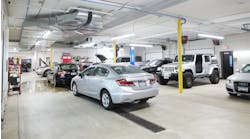At least on paper, the idea makes perfect sense to them: To counter falling profit margins on new car sales, dealers should invest in other areas of their business like parts and services.
For years, auto dealerships — particularly those selling domestic vehicles — watched as competition from their neighbors, imports and the Internet steadily shrank profit margins on new cars. Management was forced to look elsewhere for revenue. Competition also was tough in the used car market. If dealers wanted to pump up profits, they would have to turn their attention to garnering a larger slice of the lucrative parts and services market.
This, of course, meant competing with thousands of other businesses with far greater experience attracting both niche customers and a diverse customer base. Dealerships began changing how they did business. They started work earlier, closed later and opened on weekends. Some began modeling themselves after independents and franchises, offering conveniences such as quick lube services. Manufacturers took part by operating certification programs and marketing these “made over” dealer shops.
Progress by the numbers
Much of this has caused everything from slight concern to sheer panic in the aftermarket. The buzz abounds regarding dealerships encroaching the parts and services business, with many arguing that if they really take it seriously, it’d be the end of the aftermarket as we know it.
Well, the effort is there — that’s become painfully obvious with the ramped up customer relations, renovated service centers and marketing outreach.
But has it worked? Yes, for some, but it’s surely not industrywide, according to those we spoke to. The dealer foray into the service industry has so far produced mixed results. For most dealer shops, it appears their efforts have yet to reap any significant rewards.
The May 2005 edition of the National Automotive Dealers Association (NADA) AutoExec magazine notes that dealer sales of parts and services netted $85.5 billion in 2004, up from $85.48 billion in 2003. The same report also states that 66 percent of dealers now offer evening and/or weekend service hours.
Other notable facts: The average dealership service department operates 54 hours per week. In 2004, dealers provided 369,125 service stalls, employed 279,150 technicians and carried a parts inventory worth $5.6 billion.
Yet with all these investments, shops on average saw profits slip in a number of revenue areas. NADA reports mechanical labor fell from $17.2 billion to $16.64 billion. Warranty labor fell from $6.83 to $6.7 billion. Sublet work slipped almost 8 percent, from $2.66 billion to $2.44 billion.
Parts fared slightly better and produced most of the small increase in revenue from 2003. Sales of mechanical parts increased 3.3 percent, to $13.28 billion. Wholesale part sales slipped 3.3 percent, to $13.44 billion, while counter sales experienced modest growth, just .2 percent.
Overall, parts and services accounted for 11.5 percent of the total revenue generated at dealerships. That’s down from the 12.8 percent they accounted for in 1994.
Efforts under way
For Charles Hartogh, co-owner of two C&M Auto Service centers in Illinois, the reason dealers aren’t making inroads is fairly obvious. “They’re not playing to their strengths,” he says.
An industry veteran for three decades, Hartogh says dealerships are most effective when they perform dealer work — for example, warranty work and service on the models they sell. When it comes to servicing a range of vehicles, Hartogh says most simply don’t have the training or experience.
Hartogh also says the dealer business model doesn’t lend itself to a large customer base. “A Ford dealership might be able to bring in work from Ford owners. But people who drive Toyotas aren’t going to take their cars there,” he says.
Hartogh serves as the head of his local Bumper to Bumper organization (part of the Alliance) and says he and other members took up the subject of increased dealer competition several years ago. They haven’t spoken about it since because the subject hasn’t affected them, says Hartogh.
“We really aren’t their competition,” he adds. “They’re really competing with franchisers like Midas, Jiffy Lube and others.”
Steve Christie, executive director of the Automotive Oil Change Association, agrees. Christie notes that dealer shops offering quick lube services are challenging many of his member companies for business. “After years of trying, many dealers have finally gotten it right. They know how to make money off of this type of operation,” says Christie.
Hartogh remarks, however, that low cost oil changes, and similar services in themselves aren’t big moneymakers. NADA reports that shops charge on average $75 an hour for labor. Twenty-dollar oil changes that take 30 minutes to complete produce an hourly rate well below that.
Dealers argue that discount oil changes are just one piece of the puzzle. Quickie services allow them to maintain old customers, make contact with new ones and create opportunities for them to sell other services. Franchises have used a similar recipe to create billions of dollars of revenue.
Steve Lapenta, a service consultant and owner of Dealer Automated Systems in Boynton Beach, Fla., says dealers could produce similar results if they change their business model. Lapenta says that for years dealer shops have functioned as “order takers.” They only do the work customers ask of them. They don’t focus on maintenance. Independents and franchisers concentrate on maintenance. They also offer deals to get customers through their door and then find additional work to do.
“The $20 oil change or $69 brake job is just the carrot on the stick. The real goal is to find additional work and to build a relationship with a customer,” says Lapenta.
He says dealers have employed similar strategies in the past — for example, free inspections or oil changes — but never followed through. “All they did was deliver a vehicle with an oil change. They didn’t talk to the customer or push for additional services,” says Lapenta.
He adds, “When a customer calls a dealership, first of all you’re lucky to get a hold of someone who can spend the time talking. If you ask for a quote on brakes, a lot of times you’re simply told that it’s going to cost $350. When you call a franchise and ask for a price quote, the franchise salesperson will say something like, ‘What’s wrong with your brakes? What makes you think they need repaired?’ Then they’ll quote a price this way: ‘Our prices start at $69 an axle, but you’ll need to bring the vehicle in so we can give it a complete inspection.’ Which sounds better to a customer?”
Lapenta says if dealers are to compete with independents and franchises, they have to adopt the marketing strategies that made these businesses successful. Independents see repair choices made on a much more personal basis. They know that if the customer has a good experience, they will be back.
That’s why franchises and independents are light years ahead of most dealers when it comes to personal marketing, regardless of how big a dealer’s budget is. It has to do with the way a customer is spoken to on the phone, the way prices and additional work are introduced. When dealers adopt these strategies, says Lapenta, they actually have an advantage over the independents since customers seem to prefer dealer work.
Dealer shops that don’t take this approach, and it appears most aren’t, are facing some tough obstacles. Much like franchises early in their development stages, it might take dealers a while to perfect their own, unique business model, which gives independent shops some time to make improvements of their own. For now, dealers stand to make most of their profits in this particular arena on parts (a factor that helps explain the 3.3-percent boost in parts revenue).
The potential does exist, however, for dealers to leverage the parts market for even more revenue. Christie notes that dealers might have some advantages here because they’re backed by auto manufacturers and their powerful parts distribution networks. They don’t face many of the same challenges with parts ordering as the traditional aftermarket does.
If profits are stalled on repair service and increased parts revenue doesn’t satisfy dealerships, one lucrative market stands open.
The collision solution
Obscured, perhaps, by NADA’s statistics on parts and services is one area of significant growth potential: collision repair. Revenue from collision repair (labor, not parts) grew 23 percent, from $5.28 billion to $6.49 billion. Making these numbers all the more significant is the fact that fewer than 40 percent of dealers run body shops, and dealers currently account for less than one-third of the available $30- billion collision repair market.
“It’s the last great frontier to explore,” says Randy Profeta, director of collision services for AutoNation, describing what collision repairs mean to dealerships. Along with the potential revenue from bodywork, Profeta notes another significant benefit: Collision repair builds customer loyalty, a critical factor in the auto dealer business.
Profeta explains that when dealers don’t perform body repairs, they compel customers to go elsewhere, often to other dealers who end up capturing all of their service business along with their vehicle purchases.
Ken Schneider, general manager for Metro Toyota in Brook Park, Ohio, has seen this scenario play out many times. Metro doesn’t have a body shop. When contacted by collision repair customers, Schneider’s only recourse was referring them to shops that purchased parts from him.
When customers chose to go elsewhere, Schneider says many traveled to competing dealerships. Those dealerships ended up selling those customers their next new car.
Profeta notes, “When you don’t perform collision repairs, you not only lose out on a $3,000 job, you risk losing a customer and the $300,000 that follows him.”
Unfortunately for dealers looking to get back into the collision field, little help is available to aid them in opening a body shop. Profeta says there are significant differences between running a dealer collision shop and an independent. There are very few experts who understand what it takes to make a dealer shop successful. That, however, could be changing.
Outside companies have started addressing this problem. Newly founded DCR Systems offers dealers a turnkey solution. Dealers partnering with the Ohio-based company supply an appropriate 12,000-sq.-foot building, and DCR fills it with state-of-the-art equipment, trained workers and a revolutionary, cutting-edge repair system. DCR also manages the operation and offers other services, such as marketing and advertising help, to tailor each shop according to dealer demands.
Seeing the potential to sell more new vehicles, automakers already have taken a keen interest in collision repair. Just as they’ve done with mechanical services, manufacturers have started offering dealers help with their collision operations.
BMW and Mercedes offer technical support. Ford recently announced plans to deploy RealDialog’s Enterprise product with its OASIS system to 4,500 dealerships. This product houses repair information on Ford vehicles, permitting dealer technicians to more efficiently query repair information and interact with drivers.
Ford, Toyota, Volvo and others have created certified collision repair networks. Ford recently reported over 100 of its franchised dealers have joined its Certified Collision Repair Network (CCRN) and expects another 150 to 200 to qualify by 2006.
Seeing the potential for increased revenue, startup companies have developed products designed to help dealer shops. RoadSide Telematics Corp., based in California, has developed a system that allows dealers to bid for repair work almost immediately after a vehicle is damaged.
The RoadMedic product collects emergency contact information for new car owners and, in the event of an accident, automatically contacts the manufacturer’s roadside assistance program, thereby notifying the manufacturer of the accident. Since roadside assistance programs typically offer complimentary towing for accidents, manufacturers can use this service to help the customer by towing to a dealership for service. The manufacturer and dealer are thus put in the repair loop.
Lawrence E. Williams, president and CEO of RoadSide Telematics, explains, “The point here is that while the customer is being helped, the manufacturer and dealer are being given an opportunity to handle the repair work.” Williams’ product counters insurer influence by instead directing repair traffic through the dealer.
Even dealers without shops stand to benefit. Williams says dealers can collect a 20-percent commission on repairs they sublet to others. If a vehicle is totaled, the dealer can sell the owner a new vehicle.
Even if a customer has the vehicle fixed elsewhere, the dealer still has the opportunity to talk with customers, tell them what their repair options are and tout OEM parts.
Bob Miller, shop manager for Metroplex Toyota in Austin, says customers usually prefer OEM parts.
Insurers, however, still control the purse strings in the collision industry. The lower price of some aftermarket versions will make them more attractive.
Getting the upper hand
Tim Whittico, owner of Whittico’s Collision in Lincoln Park, Mich., claims dealers face unique issues that cost them business. Specifically, Whittico says management turnover at dealerships builds distrust that can drive away customers.
“We hear from people that they won’t go back to a dealer because they never get to speak to the same person. Independent shops have the advantage here,” he says.
Don Kott, owner of Tucson Frame and Body in Arizona, echoes these claims. “Dealers have their own problems. They’re constantly buying each other out, and they’re in competition with one another,” he says.
“Customers do sometimes believe they’ll get better service where they buy their vehicle. However, that’s just one aspect of the business,” Kott adds. “What matters is ownership. What matters is having someone in charge who is open to change and makes good decisions.”
Whittico downplays any talk of auto dealerships having better-trained technicians or being better fit to repair certain models. He says the resources are available for any shop to have quality techs and modern equipment.
Notable here, too, is the fact that by specializing in repairing the models they repair, dealers may be turning away owners of other models — the same phenomenon Hartogh says is at work in the mechanical field. Lapenta says that’s fine for many dealers, who would prefer to stick with the models they sell. That’s one course that might make everyone happy.


